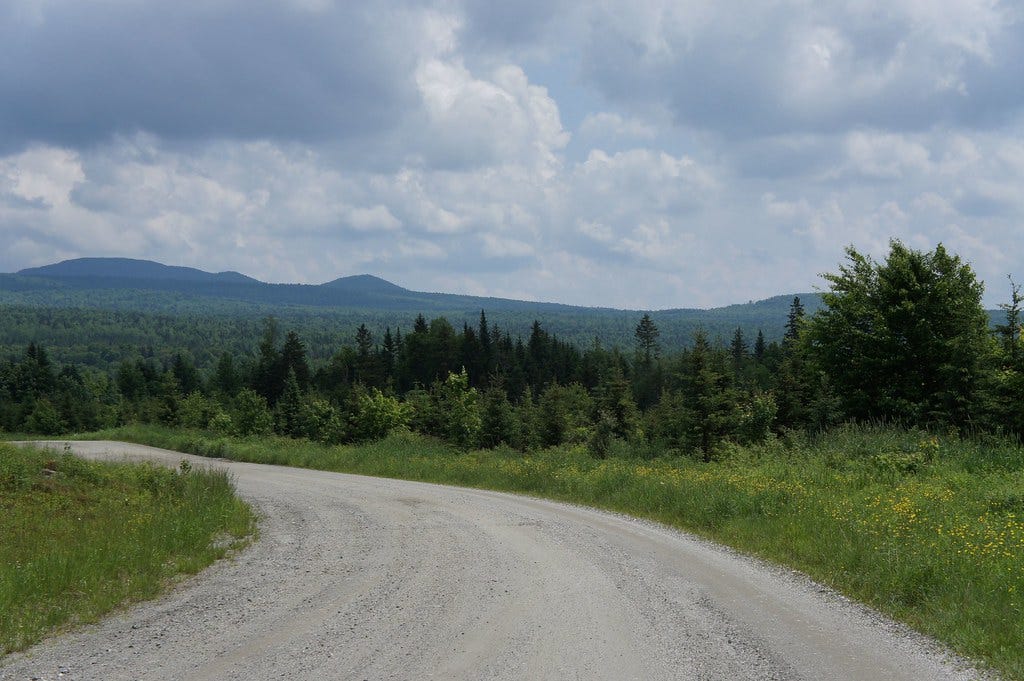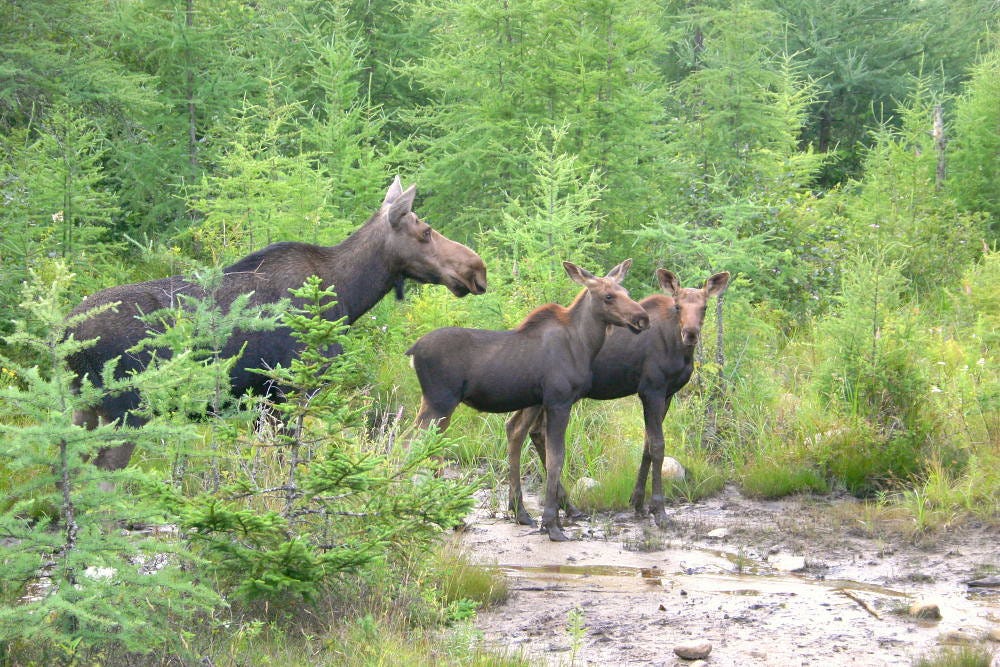One of the perks of having editorial control of your own newsletter is that you can introduce a new recurring feature series whenever inspiration strikes or if readers suggest something particular. And lately, I’ve been thinking that amid the spotlight stories on strange and unusual hikes across New England, it could be helpful to occasionally step back and size up New England with a more regional lens. For instance, a few weeks back, I wrote about a beguiling hike in Florida, Mass. that involves bypassing a train tunnel and a stone wall to reach some pretty waterfalls. How many of us know that Florida is an actual township in Massachusetts? How many people have driven the Mohawk Trail scenic byway that passes Florida?
I’m still learning about New England’s more mysterious realms, even as a near-lifelong New Englander. A lot of what you see/don’t see in New England is informed by social tradition. Growing up, my family and I logged heavy mileage in the White Mountains, Midcoast Maine, and Vermont’s Northeast Kingdom. But it was only in the last couple of years, working on guidebooks like the forthcoming Moon New England Road Trip that I began to acquaint with the other faces of New England—even the more well-trodden destinations such as the Berkshires or Cape Cod. This is a roundabout way of saying that if mentions of the Mahoosuc Range or the Metacomet Ridge within this newsletter ever leave you going, “WHERE?!?” rest assured that not only have I been there as well, but when it comes to certain parts of New England, I’m still there.
So what I’m rolling out today is the first installment of a regional micro guide to New England’s more far-flung, peculiar, and unsung rural and urban locales: New England Deep Cuts. Think of this as a series of postcards from across New England, with just enough of a glimpse of weird hikes, decadent local cuisine and libations, and unique history to have you reaching for the keys. And to kick things off on a pine-scented note, we’re going to begin with a visit to New Hampshire’s GREAT NORTH WOODS.
The Great North Woods, often called the “Northern Forest,” is a windy labyrinth of bubbling streams, lonely peaks, and dirt logging roads that squiggle through boreal forests. It comprises most of the land north of New Hampshire’s White Mountains. You would think that being next door to one of the most popular hiking regions on the east coast would create a spillover effect for Great North Woods tourism, but the strange thing is that few White Mountain visitors seem to drive beyond the Whites into the northernmost pocket of New Hampshire. Here are two figures that put this in perspective. It’s about 50 miles from the southern entrance of the Great North Woods to the Canadian border. But the regional population here is only around 3,000 people.
For decades, most of the action in the Great North Woods has been logging and pulp processing. But the industrial presence up here has waned in recent years, as you’ll see when driving through the city of Berlin, en route to the northern woods. Berlin once bustled as a hub of pulp mills where workers turned wood chips into thicker and condensed material, ready to be shipped to paper factories. Most of the mills—including the oldest operating pulp mill in the world—have now shut their doors. The decline has cost Berlin thousands of jobs and sparked a more regional dialogue about what comes next, after this era.
Recreational tourism could at least partially fill the void. New Hampshire is actively promoting the Great North Woods as a special place where one can experience the quietude and rustic quality of northern New England in ways that are fleeting in the Whites or the Lakes region. My first visit to the Great North Woods involved driving up a ludicrously steep road through Dixville Notch—a gateway-like mountain pass made of sheer cliffs and rock formations. (One of which you can climb to the top of: we’ll come back to that later.) More recently, I took an amble through the boggier Nash Stream Forest on the Cohos Trail, a 170 miles-long path which runs from the heart of the White Mountains through the Great North Woods to the source of the Connecticut River on the U.S./Canada border. The trail was conceived by a local journalist named Kim Nilsen and hacked together with the help of hundreds of volunteers.
Then there’s the non-hiking crowd, which substantially outnumbers the hikers in the Great North Woods. Many of the trails up here are shared with ATVs during the warm seasons and snowmobiles in the winter. The lakes—especially the sprawling and deep blue Connecticut Lakes, close to the Canadian border—are the domain of wizened old fisherfolk with names like Burt and Elspeth. You won’t find many luxury resorts in the Great North Woods, but what you will encounter more often are “camps”—the vague term for modest cabins nestled in the forest. These are rustic vacation retreats for people who don’t wish to stand in line for a photo atop Mount Washington, or who would like to avoid getting into splashy fisticuffs over a Saco River tubing collision.
What this means for hikers is that the Great North Woods are not only more peaceful than the Whites, but many of the hiking trails up here are more rugged, grown-in, and isolated. Some, such as the Old Summer Club Trail to the Percy Peaks—two towering twin mountains that look like volcano cones—were pretty much forgotten until trail volunteers from organizations like the Cohos Trail Association did the grueling work of hauling out slash (woodsy detritus) installing new trail markers, and rebuilding bog bridges through soggier stretches. Even to this day, some of the Great North Woods’ most interesting hikes don’t show up on GPS maps used by websites like AllTrails. Cellular service up here can be spotty as well. Every time I’ve visited the Great North Woods, I’ve brought paper maps of the roads I’ll be driving and the trails I’ll be hiking.
And speaking of road driving, did I mention moose? If you’ve ever wanted to lay eyes on one of these mystifying creatures, which the author Bill Bryson once described as “a cow drawn by a four year-old,” the Great North Woods is your best bet. Abundant wetlands and deeply serene woods make the Great North Woods hospitable territory for antlered behemoths. You’re quite likely to encounter one out in the brush (if you stumble upon one, talk to the moose softly, back away, and in the unlikely event that the moose seems ready to charge, retreat and get behind a solid tree or a boulder.) Another common moose sighting venue is the stretch of Route 3 between the town of Pittsburg and the Canadian border. Moose dart across this road with such frequency that it’s dubbed “Moose Alley.” Just be sure to drive slowly. You don’t want to run into a moose with your vehicle. It could kill you, and you’ll almost certainly need a new car.
With the madness of fall foliage season fast approaching, the Great North Woods is practically inviting hikers to skip the more mainstream north country destinations and venture further north. I’m planning to spend a portion of Columbus Day weekend up here, camping on the shores of Lake Francis and seeking out the elusive and visually stunning Garfield Falls amid the remote logging roads where Google Maps ceases to function. Hiking around the Great North Woods is how I imagine it must have felt to visit the Whites decades ago, when wilderness recreation was a more exoticized kind of activity and a more masochistic one too (just imagine the plumes of mosquitoes that could easily find their way into an old canvas tent after dark, drawn to a lantern.)
If you’re thinking it may be time to find out what lies north of the White Mountains, I recommend starting your first Great North Woods pilgrimage with any of the following hikes and joints:
CHOOSE A BASE CAMP
There are two prominent towns in the Great North Woods, when it comes to lodging and dining options. Colebrook, which has a charming and stroll-able downtown strip, will have you situated closer to Dixville Notch and the Nash Stream Forest. But if you’d prefer to explore the Connecticut Lakes region, then your best bet is Pittsburg, a less centralized but more staggered town about 30 minutes to the north of Colebrook.
HIKE HERE
Table Rock (Dixville, NH): In New England, how often do you get to stand atop a 700 foot tall tower of stone, on a “summit” that’s barely 3-4 feet wide, with sheer drops on most sides? Right here, at Tower Rock, which looms above Dixville Notch. The Three Brothers Trail is the most scenic approach to the top, with waterfalls along the way.
Hurlbert Swamp (Stewartstown, NH): This cedar swamp feels like a slice of the Deep South in northern New England, and it’s reachable by way of a grassy road with lovely glimpses of wetlands. Just be careful when walking the bog bridges that meander through the swamp. They’re slicker than Al Pacino’s hair in The Godfather Part II.
North and South Percy Peaks (Stratford, NH): The Great North Woods doesn’t offer the abundance of mountains that you find in other parts of New Hampshire, but the massive Percy Peaks are an exception. Just looking at their 45 degree angle slopes feels inspiring and slightly intimidating. The scrambling up North Percy is thrilling, if done on a sunny day. Avoid this hike in wet weather. It gets dangerously slippery.
Little Hellgate Falls (Clarksville, NH): It’s worth braving the maze of logging roads near the Connecticut Lakes to reach “Little” Hellgate Falls, which more copious and elaborate than the name implies. The short trail features wooden stairs made of hewn logs: a relic of the timber era and a window into the falls’ dark history. Loggers used the falls to transport timber and several were killed by log jams atop the cascade.
Fourth Connecticut Lake (Pittsburg, NH): This may be my favorite hike in northern New Hampshire. Park at the Canadian border by a large Nature Conservancy sign, climb a ridge through the boundary mountains, zig-zagging across the border (there are markers in the ground to indicate whether you’re in the U.S. or Canada) and you’ll soon reach a quiet fen from which the Connecticut River flows to Long Island Sound.
REFUEL HERE
The Rainbow Grille (Pittsburg, NH): Trout almondine and juicy bacon-wrapped steaks, steps away from the shores of Back Lake. I don’t think there’s much more to be said.
Buck Rub Pub (Pittsburg, NH): Arguably the hub of the universe in Pittsburg, where ATV riders, hunters, fisherfolk, and hikers converge for beer and big ass steak subs.
Mostly Muffins (Colebrook, NH): I really adore this family-fun muffin house. Not just for the decadent muffin flavors (s’mores!) but also the fairy-themed interior tea room.
Coös Brewing Company (Colebrook, NH): Your last stop for brewed-onsite craft beer before you hit Canada heading north. They feature a beer called “Melancholy Porter.”
SLEEP HERE
Campsites are plentiful and a bargain in the Great North Woods, but my favorite is without a doubt Lake Francis State Park (Pittsburg), which is steps away from the shores of one of the region’s most visually arresting lakes. If you’d rather spring for your own cabin with a full-kitchen (often a good idea up here, as local restaurant hours can be limited) you’re going to want to set your sights on Pittsburg. Many lodging outfits up here offer cabins: most recently, I had a great stay at Partridge Cabins (Pittsburg) this past winter while reporting a story about mid-pandemic snowshoeing. But the cabins Tall Timber Lodge (Pittsburg) are also quite cozy.










